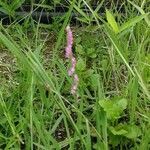Plant at fl. c. 10–100 cm. tall, mostly glab. Roots several, ± spindle-shaped, on vertical sympodial axis. Stem erect, slender to stout, much exceeding lvs. Basal lvs 2–6, c. 5–20 cm. × 5–15 mm.; lamina narrow-elliptic tapering into petiole of about equal length; stem-bracts 2–4. Spike c. 2–15 cm. × 5–10 mm.; fls ± crowded, almost sessile. Ovary almost glab. to closely glandular-pubescent. Per. 4–7 mm. long, ± cylindric, rose-red to pink except for white labellum. Dorsal sepal ± oblong, slightly concave except at tip; laterals slightly pouched at base, obtuse to subacute. Petals ± oblong, ± adnate to dorsal sepal. Labellum broad and recurved at tip; upper margin ± laciniate and much crisped and irregularly thickened; base sessile, concave, smooth except for 2 prominent lateral calli which fit beneath stigma in undissected fl. Column narrow below stigma; anther obtuse, overtopping stigma; stigma broad and prominent, sts lacking rostellum, us. overtopped by delicate, membr., ± laciniate column-wings.
Leaves 2–4, obliquely erect in basal cluster, linear-lanceolate, 40–85 × 2–8 mm, deep green. Flower stem 100–200 mm tall, 20–50-flowered. Flowers 3.5–4 × 1.5–2 mm, glabrous, pink with white labellum, tubular; sepals, petals and labellum overlapping to form tight, projecting tube, tips free. Dorsal sepal c. 3.5 × 1.2 mm, projected forwards. Lateral sepals c. 3.5 × 1 mm, projecting forwards close to labellum. Petals c. 3 × 1 mm. Labellum 3-lobed, c. 3 × 1.3 mm when flattened, midlobe narrower and shorter than base; base tubular, with 2 papillate/hairy basal glands; midlobe remaining almost tubular, apex papillate, margins incurved, crinkled, and irregularly toothed. Column c. 1.5 mm long.
An orchid. It is 50 cm high. The roots are 2-3 mm across. It has a few leaves in a ring at the base. The flower stalk has numerous flowers arranged in a spiral on the upper part of the stalk. Each flower is 6 mm long. Only one third of the flowers open at one time. The colour can be white or with purple.



